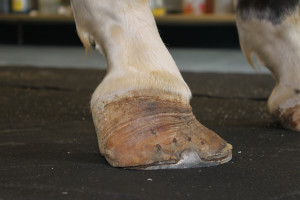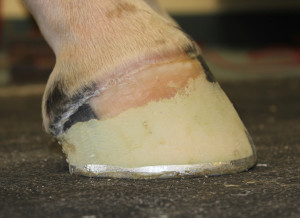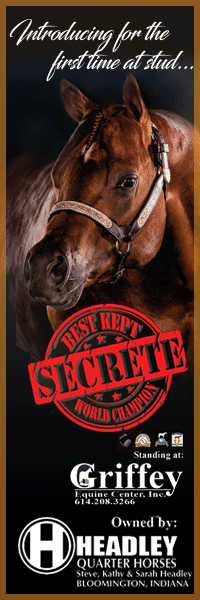Club Foot in Horses
Click here to read the complete article
By Heather Smith Thomas
 Most horsemen define a club foot as hoof and pastern angle of more than 60 degrees, making the foot more upright than normal. The affected hoof is usually stumpy with a short toe and long, upright heel. Contracture of the flexor muscles and deep digital flexor back tendon (which attaches to the coffin bone inside the hoof) results in the horse walking on the toe—and the heel area doesn’t get much wear. The hoof may have a steeper angle than the pastern; the hoof/pastern axis is often broken forward rather than straight.
Most horsemen define a club foot as hoof and pastern angle of more than 60 degrees, making the foot more upright than normal. The affected hoof is usually stumpy with a short toe and long, upright heel. Contracture of the flexor muscles and deep digital flexor back tendon (which attaches to the coffin bone inside the hoof) results in the horse walking on the toe—and the heel area doesn’t get much wear. The hoof may have a steeper angle than the pastern; the hoof/pastern axis is often broken forward rather than straight.
Travis Burns, Lecturer and Chief of Farrier Services at Virginia Tech (the Virginia-Maryland Regional College of Veterinary Medicine), says that in dealing with club feet it’s best to try to start treatment when the horse is young. “The younger the animal, the better the result and prognosis for future soundness. In young foals we try to physiologically stimulate the foot to improve—by gently lowering the heel and doing everything we can to protect the toe. We want to make sure they don’t wear the toe away. When that happens there is little to no resistance to the deep digital flexor tendon and the problem just continues to get worse,” he says.
“If you trim the heels, this increases tension on the flexor tendon and can be counter-productive, but we gently lower the heels and try to stimulate them a little bit, to relax. There are a few medical treatments that can be associated with that, so it is important to have a veterinarian involved, early on, in the treatment strategy.”
It is important to look closely at every foal, early in life, and start trimming them at about 2 to 3 weeks of age for the first time. The farrier can assess the feet at that time to see if something needs more frequent trim or treatment.
“Some club feet are very obvious when the foal is born and other cases take a bit of time to develop. Careful monitoring of all foals, and consistent trimming should help these situations, though not everyone does this. The horse owner or breeding farm may not take the time to have foals looked at every two weeks, and may not have the best farriers working on them,” says Burns. The mares and foals may be out on pasture and not being checked very often, and a foal may have a serious club foot by weaning time or at 9 or 12 months when brought in to be sold.
CAUSES
“There can be several causes that can lead to a club foot. Often there is a nutritional component. Foals need a well-rounded, balanced diet that does not go beyond the nutritional requirements. Fast-growing foals with developmental problems may be more at risk. Thus it pays to have a veterinarian and equine nutritionist involved in the diets of mares/foals and have the correct nutritional plan,” says Burns.
“Undoubtedly there is a genetic component, so it is important to stop breeding the horses that have club feet, upright feet or severely mismatched feet. These problems seem to show up in certain families of horses. Unfortunately many horse breeders tend to perpetuate problems. If a horse eventually cannot do the job it was bred to do, many people then breed that horse!” This perpetuates a lot of conformational and genetic weaknesses that lead to deformities or injuries. The horse becomes injured and can’t continue its career, and so it is used for breeding.
“Club feet can also be due to a pain response. Often the club foot or feet are secondary to OCD lesions in the shoulder, for instance,” says Burns. If it’s painful for the horse to put weight on that limb, or favors it a little bit, the flexor muscles eventually contract and pull the heel up, with the horse walking more on the toe. With less wear on the heels, they grow longer and create the upright foot.
The contracted muscle/club foot condition is a common growth problem in young horses (up to 6 months of age), causing upright pasterns and a tiptoe stance. This is often seen in foals with developmental problems due to rapid growth. If discovered soon enough, this condition can be reversed by altering the foal’s diet and reducing stress on the limbs.
A club foot may also result from injury if the horse is lame and keeps favoring the sore foot, not putting much weight on the heel. This lack of use may cause shortening and contracting of the muscles and tendons in that leg, eventually making that foot more upright. The high heel and limited heel pressure and lack of expansion usually causes the club foot to become contracted, as well.
“Some people feel that in foals the mismatched feet and tendency toward club foot on one front foot has to do with the grazing stance,” he says. The foal’s legs are long and his neck is short, so he places one front foot forward and the other back, so he can reach the ground to eat grass. If he has a preference for which foot is always forward (with more weight on the heel) and which one is always back (with less load on the heel), the feet may start to become mismatched. The foot with less weight on the heel tends to develop a longer heel.
A mild club foot may worsen if trimmed infrequently or improperly and by the time the horse is 2 or 3 years old the problem becomes more obvious. The horse may develop an uneven stride and rough gait (and some loss of agility) due to the mismatched hoof angles. The hoof horn may grow faster at the heel than at the toe, accentuating the problem. That foot may need to be trimmed a little more often so the extra heel growth won’t cause the foot to become more upright between trimmings. Otherwise the abnormal foot angle eventually causes misalignment (and sometimes damage) of the coffin bone. The sole at the toe becomes more susceptible to bruising since most of the weight is carried on the toe and the sole is thinner under the front of the tipped-down coffin bone.
 TREATMENT AND MANAGEMENT OF CLUB FOOT
TREATMENT AND MANAGEMENT OF CLUB FOOT
“It can be very tricky if a person is trying to lower the heel to stimulate relaxing of the muscle/tendon unit without causing pain/pressure or increasing the stress and strain on it too much. So it is important to only trim the foals’ feet that currently touch the ground, and they should still touch the ground post trim. If the heel does not touch the ground after you’ve trimmed it (and the foal is walking on his toe) you have trimmed it too much. There is often a little bit of trial and error to try and determine what each horse can or cannot tolerate,” says Burns.
Keep in mind that a club foot in a young horse is usually part of an upper leg problem such as DOD (developmental orthopedic disease) or might be due to OCD (osetochondritis dessicans) lesions in a joint higher in the legs, or inflammation of the growth plates in the leg bones. The muscles contract because of the pain response, pulling on the coffin bone and changing the hoof angle. This is sometimes treated medically, such as with oxytetracycline or other medications aimed at relaxing the tense muscles and reducing tension on the deep digital flexor tendon.
“Sometime within the 4 to 8 month window, if the foal has not responded well to the trimming or medical treatments, this may be a time to start thinking about surgery. If a foal has a club foot that is vertical (90 degree angle), the veterinarian may perform an inferior check ligament desmotomy, cutting the check ligament to release some of the pressure. At that point shoes are applied—to protect the toe and increase the base of support. The heels are lowered to try to achieve a near normal palmar angle. Sometimes shoe extensions are used to protect the toe or put the shoe where the foot would be—if the toe has been worn away,” says Burns.
“If the club foot is beyond 90 degrees (tipped forward), we would do a deep digital flexor tendon tenotomy, cutting that tendon that is pulling the heel up. There are varying degrees of success with this approach. Obviously, the more severe the deformity, the more guarded the prognosis, but it’s not uncommon for young horses (4 to 8 months of age) to have the inferior check ligament vand go on to soundness. When you cut the deep digital flexor tendon, those chances are reduced slightly, but many of them do go on to be sound enough for light riding,” he says.
The prognosis would vary on a case by case basis, and the horse owner should discuss this with the veterinarian. “The only shoeing difference between the two surgical treatments is that often when the deep digital flexor tendon is severed it is common to incorporate some sort of heel extension on the shoe, whereas we wouldn’t need to do this when cutting the inferior check ligament,” he explains.
With the adult horse that is most mildly club-footed, frequent trimming (not taking very much off at once) can often keep it from getting worse, and allows the horse to function fairly normally. “In the older horse, where surgery is not an option, or the owner doesn’t want to pursue surgical treatment, simply managing the hoof capsule (as best possible) can keep these horses sound. It’s important to not let too much time elapse between trimming/shoeing. Small, subtle changes with shorter shoeing cycles and limiting the amount of heel or imbalance can help maintain the hoof so it grows in a more even pattern from heel to toe,” says Burns.
“If it is growing a lot more heel than toe, there’s a problem. The opposite foot will tend to grow a lot more toe than heel, and that in itself is a problem, so frequent trimming can get them from becoming too mismatched with an uneven stride. It is important to keep the hoof capsule as healthy as possible,” he says.
“Often when we are dressing the hoof wall back to eliminate any flare, distortion or dish in the toe, when we try to match the dorsal surface of the dorsal phalanx, it’s very common to run out of wall to safely and securely nail the shoe on. So glue-on shoes can be a good alternative for upright feet. This also eliminates some of the shoe loss, since upright feet tend to lose shoes more often than the low foot just because they are more difficult to fit,” he says.
“Having the upright heel predisposes the hoof to more risk for shoe loss so we need to pay careful attention to where the breakover is and where the shoe is placed on the upright foot. The shoe should not be pushed out beyond the perimeter of the upright hoof, even though that’s still a very common practice, unfortunately,” says Burns. Careful monitoring is important, to figure out what works best for that particular horse.
PREVENTION
Club foot is very common in horses, and is seen almost exclusively in the front feet. “Unfortunately we see a lot of this in foals, and many adult horses that have mismatched feet—more mismatched than normal. No horse has two identical front feet (or hind feet); but we don’t want to see severely mismatched hoof angles or a club foot. These can be difficult to manage,” says Burns.
“A big step in prevention would be more careful breeding selection (not breeding horses that have this defect). In foals, proper nutrition is important, along with routine, proper trimming (something that is often neglected). In the adult horse, frequent trimming and proper care of the hoof capsule is also important, and getting away from the idea that the feet should match perfectly—and trying to force them to match or have the ideal angle. An upright foot needs to continue to be upright. You can’t simply chop off the heel to make it look ideal/normal or you may make the horse lame or crippled.” This happens all too often when an owner or farrier becomes too ambitious in trying to “fix” it and makes it worse for the horse.










